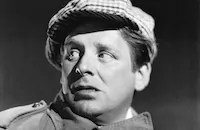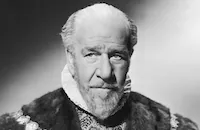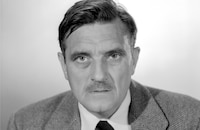The Green Years

Brief Synopsis
Cast & Crew
Victor Saville
Charles Coburn
Tom Drake
Beverly Tyler
Hume Cronyn
Gladys Cooper
Film Details
Technical Specs

Synopsis
In the year 1900, following the death of his mother, eight-year-old Catholic Robert Shannon is sent from his home in Dublin, Ireland to live with his mother's Protestant family, the Leckies, in the small coastal town of Loganford, Scotland. Some of the Leckies, Robert soon discovers, hold a long-standing grudge against Robert's mother for running off to Ireland to marry a Catholic. While Papa Leckie, a sanitarium inspector and the sternest of the Leckies, strongly disapproves of Robert's devout Catholicism, Robert's alcoholic great grandfather, Alexander Gow, is fond of the boy and protects him from other family members. Grandma Leckie, however, is determined to end Robert's budding friendship with his eccentric grandfather and vows to turn him into a god-fearing lad. Robert's first day at school ends in humiliation as he is taunted by fellow schoolmates who ridicule the green, flowered uniform that Grandma Leckie made for him. Fearing that he will be trounced in a fistfight with Gavin Blair, the school's most notorious bully, Robert goes to Alexander for advice on self-defense. Robert defends himself honorably in the fight, after which he and Gavin become fast friends. When Robert later asks Papa Leckie for fifteen shillings to buy his first Communion suit, Papa Leckie angrily denies the boy's request, leaving Robert with no alternative but to sell his cherished microscope for the money. Alexander refuses to let Robert get rid of his microscope, however, and instead takes Papa's encyclopedia and sells it for fifteen shillings. Years pass, and Robert, now a star student in high school, receives a special science award from his headmaster, Professor Reid. Although his friends are leaving to attend university, Robert stays in Loganford to work and fulfill his obligation to the Leckies. Professor Reid, believing that Robert is too talented to be working at the Loganford Boiler, suggests that he apply for the Marshall Scholarship to study medicine. Papa Leckie rejects the idea of sending Robert to a university, but when Robert wins the scholarship, Mama Leckie and Alexander help the boy study in secrecy for the university entrance examinations. The intensive studying exhausts Robert to the point of physical collapse, however, and he fails the exam. Later, tragedy strikes when Gavin is struck by a train and dies. Having lost his best friend, and having failed in all his attempts to attend the university, Robert tells his priest that he has lost his faith in God. One day, when Alexander disappears, Robert, suspecting that he fled as a result of Papa Leckie's cruelties, berates Papa Leckie and other family members for their greedy desire to gain a profit from Alexander's life insurance policy. Alexander is eventually found but he dies shortly thereafter. Later, the Leckies are surprised when a recently added codicil to Alexander's will is discovered, in which it is stipulated that all of Alexander's life insurance money is to be used to pay for Robert's university education. With his tuition paid, the promising young scientist attends his first day at the university with his former schoolmate and sweetheart, Alison Keith, at his side.

Director
Victor Saville
Cast

Charles Coburn

Tom Drake

Beverly Tyler

Hume Cronyn

Gladys Cooper

Dean Stockwell

Selena Royle

Jessica Tandy

Richard Haydn
Andy Clyde

Norman Lloyd
Robert North

Wallace Ford
Eilene Janssen
Hank Daniels

Richard Lyon

Henry O'neill

Henry Stephenson
Norma Varden
Forrester Harvey
Lumsden Hare

Morris Ankrum
Herbert Evans
Peggy Miller
Mitchell Lewis
Harry Allen

Sylvia Andrew
Gabriel Ganzona
Guy Stockwell
David Mcmanus
Richard Glynn
John Considine
David Bair
Richard Scott
Blanche Rose
Bill O'leary
Kathryn Bates
Charles Sadler
Jean Ransome
George Mcdonald

Brandon Hurst
Charles Bates
Pete Cusanelli
Carmela Restivo
Dorothy Reisner
Eric Mayne

Yvette Duguay
Bonnie Henjum
Virginia Ellsworth
Ada Adams
Ashley Cowan
Russell Burroughs
Boyd Davis
Edgar Sherrod
John Power
James Reid
Jimmy Aubrey
Tom Pilkington
George Broughton
Dick Ames
Norman Borine
John Mccallum
Tom Leffingwell
A. D. Sewall
Violet Seton
Norman Ainsley
William Scully
Colin Kenny
Andy Colman
Bobby Hale
Tommy Hughes
Penny Parker
Helen Dickson
Robert Cory
Crew
Robert Ardrey
Edward Baravalle
Robert Bronner
Robert Burns
Mark Davis
Jack Dawn
Charles G. Decrof
Thomas Edwards
George Folsey
Cedric Gibbons
A. Arnold Gillespie
Leon Gordon
Jack Greenwood
George Frideric Handel
Irene
Donald Jahraus
Robert J. Kern
Sonya Levien
Madge Macdonald
M. J. Maclaughlin
Warren Newcombe
Hans Peters
George Richelavie
Douglas Shearer
Robert W. Shirley
Newell Sparks
William Steinkamp
Michael Steinore
Herbert Stothart
Valles
Don T. Whitmer
Edwin B. Willis

Photo Collections
Videos
Trailer
Hosted Intro
Film Details
Technical Specs

Award Nominations
Best Cinematography
Best Supporting Actor
Articles
The Green Years
Dean Stockwell, age 10 at the time, was still a newcomer to films, but his portrayal earned him excellent reviews from Variety, "[Stockwell] is the particularly bright spot in the well-turned cast , as well as a top addition to the list of Hollywood juve[nile] players. Kid, whose father, Harry Stockwell, is known to Broadway for leads in Marinka and the Chi[cago] company of Oklahoma! first appeared in Metro's Anchors Aweigh [1945]. In the present film he gets real opportunity to demonstrate a sensitivity and true dramatic poignancy that definitely set him off from the usual studio moppets. He has the ability to translate the most subtly-shaded nuance without at any time evidencing the precocity that so often makes audiences waver at the prospect of being forced to see a new child screen find."
Another child appeared in The Green Years, but the director Victor Saville took great pains to hide her. Her name was Tandy Cronyn, and her father Hume Cronyn later explained, "I played a penny-pinching sanitary inspector, Papa Leckie. Jessica [Tandy, Cronyn's wife], who in real life (forgive the ingallantry) is a couple of years my senior, played my daughter. Yes, daughter. Jess had made a test and was immediately given the part. She was newly pregnant at the time, but as the film would be finished before the pregnancy showed, we didn't feel it was necessary to reveal her condition to the studio. Then there was a change of directors and the film got postponed for several months. That blew it. I can remember sitting in the M.G.M. commissary with Jessica explaining the situation to Victor Saville, the new director. Victor swore gently and looked reproachfully at me. "We'll have to recast." Of course. While we were delighted by the prospect of having another child, it was a pity to lose the opportunity of working together again, and besides, Jess was having a less satisfactory time at [Twentieth Century] Fox than I was at Metro. They simply didn't seem to know what to do with her there.
I kept running into young actresses on the lot who were testing for the part of the Leckie daughter. All of them volunteered that before making their test they'd been shown the one Jess had made and been told, in effect "This is what we want." Such a proceeding was highly unusual. As the date to commence shooting The Green Years got closer and closer and the part of Leckie's spinster daughter remained uncast, there was a great deal of speculation as to what the outcome would be. Victor resolved the mystery in a conversation with Jessica. "If you're willing to do it, I believe I can shoot it so that no one will ever know you're not a virgin." That was going to be quite an accomplishment, as by now Jess was in her seventh month and very big. Never has an actress been shot behind so many pieces of waist-high furniture, carrying so many trays or bundled up in so many shawls. And never has an actress been treated with more loving care and consideration on the set. The director, assistant directors, and crew might have all been in training for service in a maternity ward. Jess was made to take regular rest periods, lunch was served to her in her dressing room, and her working day was short. With the timing that only an experienced and gifted actress can accomplish, she managed to give birth to our daughter, Tandy, one day after completion of principal photography: November 26, 1945."
Producer: Leon Gordon (uncredited)
Director: Victor Saville
Screenplay: Robert Ardrey and Sonya Levien, A.J. Cronin (novel)
Cinematography: George Folsey
Art Direction: Cedric Gibbons and Hans Peters
Music: Herbert Stothart
Film Editing: Robert J. Kern
Cast: Charles Coburn (Alexander Gow), Tom Drake (Robert Shannon as a young man), Beverly Tyler (Alison Keith as a young woman), Hume Cronyn (Papa Leckie), Gladys Cooper (Grandma Leckie), Dean Stockwell (Robert Shannon as a child), Selena Royle (Mama Leckie), Jessica Tandy (Kate Leckie).
BW-125m. Closed Captioning.
by Lorraine LoBianco
Sources:
Variety March 8, 1946
A Terrible Liar by Hume Cronyn

The Green Years
Quotes
Trivia
Notes
The onscreen credits read, "Metro-Goldwyn-Mayer presents A. J. Cronin's The Green Years." Contemporary sources note that M-G-M paid a record sum for a novel of $200,000 for the film rights to A. J. Cronin's best-selling book, topping the previous record of $175,000, set by Warner Bros. in its acquisition of the rights to Edna Ferber's Saratoga Trunk (see below). Cronin's novel was serialized in Redbook magazine, but the dates are undetermined. A May 1944 Hollywood Reporter news item indicates that Sam Zimbalist was originally assigned to produce the film. Harold S. Bucquet was named as the director in an August 1945 New York Times article. The article also noted that producer Leon Gordon and Bucquet spent "considerable time" searching for actors to play "Robert Shannon" as a boy and as a young man before settling on Dean Stockwell and Tom Drake, and that some "large-scale exterior" filming was set for Washington state.
According to M-G-M News, Reginald Owen was originally set for the part played by Lumsden Hare. Although a 1945 M-G-M news item noted that Nickie Johnson "won a featured role" in the film as a Glasgow librarian, her appearance in the released film has not been confirmed. A 1949 Daily Variety news item notes that an English appeals court tossed out a lawsuit filed against M-G-M by BBC critic Edith Arnot Robertson, who, after reporting negatively on the film, alleged that she was libeled and slandered by the studio in a letter asking that she be barred from reviewing M-G-M films for the BBC in the future. Although Robertson initially won her suit againt M-G-M, the decision was reversed in appeal. This film marked the screen debut of child actor Guy Stockwell, brother of Dean Stockwell. Charles Coburn was nominated for a Best Supporting Actor Oscar, and George Folsey was nominated for a Best Cinematography Academy Award. Coburn, Tom Drake, Beverly Tyler, Hume Cronyn and Dean Stockwell reprised their roles in a Lux Radio Theatre broadcast on January 13, 1947.
















